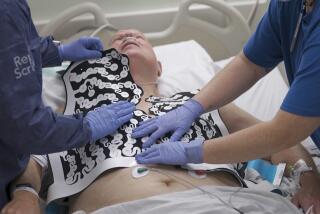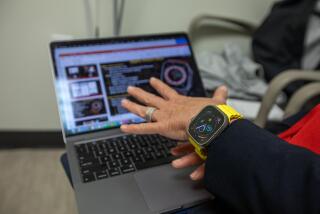A Main Squeeze for the Heart
- Share via
Bernie Bierman’s life has been full of challenges. A cabin boy on a Mississippi River log boat at 13 and a moonshiner in his 20s, he spent time in farming, oil field and marine contracting, and land development. He helped put out the fires in Kuwaiti oil fields after the Gulf War and was a leader in the cleanup after Hurricane Hugo in 1995.
But the biggest challenge for the 57-year-old native of Branson, Mo., came last year when the shortness of breath he had been experiencing became worse. His hands and feet began to swell. “It gets pretty uncomfortable,” he said. “You can’t sleep at night because you can’t get your breath. It’s a very claustrophobic feeling.”
Tests showed that Bierman was one of 500,000 Americans suffering from congestive heart failure, a condition in which the heart is unable to pump as much blood as the body needs. Bierman’s heart was working at only 20% of its normal capacity.
On April 15 last year, Bierman underwent cardiomyoplasty, a surgical procedure that has been around for more than a decade but that has been relatively unused until recently. Dr. H. Edward Garrett Jr. of Baptist Memorial Hospital in Nashville freed one end of a muscle in Bierman’s back, wrapped it around the heart and inserted two fine electrodes, connected to a pacemaker-like device, into the tissue.
Stimulated by the electrodes, the back muscle--called the latissimus dorsi--slowly began acting like heart muscle, strengthening the heart’s own pumping contractions and boosting blood output.
Bierman’s surgery was part of a large clinical trial of cardiomyoplasty at 20 medical centers, including UCLA, that is yielding encouraging results.
Today, Bierman sleeps soundly, walks freely and enjoys playing with his 23 grandchildren, although he still has some physical limitations. “I can’t pick up heavy loads,” he said, “but I have a very good quality of life. It’s almost like a miracle for me.”
Cardiomyoplasty “has the potential to help thousands of patients who have advanced heart failure but can’t get a transplant,” said Dr. Marc A. Silver of the Loyola University Medical Center in Chicago. Cardiac surgeons perform about 2,000 heart transplants in the United States every year, he noted, but at least another 7,000 patients are good transplant candidates for whom no organ is available.
“There are many, many thousands more who are not eligible for a transplant because of age, kidney problems and other contraindications,” Silver added. “That’s the niche cardiomyoplasty fills.”
Without surgery, “these patients have a high mortality rate and a fairly short life expectancy,” Garrett said. “Only 50% of them respond to [medication] very well and, even with medical therapy, their life expectancy is just three or four years.”
Scientists started trying to use other muscle tissue to assist the heart as far back as the 1930s, but such attempts suffered from the simple fact that heart muscle is unlike most other muscles in the body. Whereas muscles in the arm or leg become exhausted after a few minutes or hours, heart muscles contract repeatedly for a lifetime without tiring out.
The advance that made cardiomyoplasty possible came in the 1980s when Dr. Ray C.J. Chiu of McGill University in Toronto and Dr. Larry Stephenson of the University of Pennsylvania discovered that back muscles could be trained to act like heart muscles. By applying a specific sequence of electrical pulses to the tissue over a period of weeks, they found, they could stimulate the growth of muscle fibers that would not tire out.
After that training period, the transplanted muscle becomes an effective support for the weakened heart.
In the procedure, surgeons first make an incision in the back and free one end of the latissimus dorsi. Electrodes are attached and it is stimulated to ensure that it will contract properly. After the surgery, other shoulder muscles take over for the latissimus dorsi and shoulder movements are not impaired.
A segment of rib is then removed so that the muscle can be threaded through into the body cavity.
After the back wound is closed, the patient is turned over, the chest is cut open and the ribs are spread. Sensing electrodes are attached to the heart to monitor its normal electrical activity, then the loose end of the latissimus dorsi is wrapped around the heart and secured.
Both sets of electrodes are then attached to the pacemaker-like amulet that controls the muscle contractions, and the chest is closed. The device is manufactured by Medtronic Inc. of Minneapolis, which is sponsoring the current clinical trial of the procedure.
The patient may be hospitalized for as long as three weeks recovering from the surgery, and training of the muscle may take several more weeks.
The first tests of cardiomyoplasty in the United States began in 1988, but the results were mixed. Although 80% of patients who survived the procedure benefited, about one in three patients--many of them in weakened conditions--did not survive the stress of surgery.
“It’s a very complex operation on a patient who is quite ill,” said Dr. Phillip Spratt of St. Vincent’s Hospital in Sydney, Australia. Researchers have improved the survival rate by selecting patients who are healthy enough to live through the operation and the training period.
The real trick, Silver said, is in finding the right patients. For the current clinical trial being conducted at more than 20 sites around the country, including UCLA, the team rejects patients who have extremely high pressures in the lungs, who are too weak to exercise, or who have too many other problems, such as emphysema or liver damage, that would limit their ability to survive the surgery.
“It’s restrictive, but it’s much less restrictive than the guidelines for heart transplants,” he said.
The estimated $60,000 cost of cardiomyoplasty is half to two-thirds the initial cost of a heart transplant. And unlike a transplant, there is no need for immunosuppressive drug therapy, which costs another $20,000 a year.
One of the remaining problems, Silver said, is sudden death from heart failure unrelated to the surgery, such as from arrhythmia. In the future, he said, surgeons will probably have to use drugs to suppress irregular heartbeats, and the Medtronic device is being redesigned to include a built-in defibrillator.
(BEGIN TEXT OF INFOBOX / INFOGRAPHIC)
Wrapping the Heart
A little-used surgical procedure in which back muscle is wrapped around a weak heart to help it pump may provide an alternative treatment for many patients not eligible for a heart transplant.
1. Surgeons make an incision in the back, free one end of the latissimus dorsi and thread it through the ribcage.
2. After sensing electrodes are attached to the heart to detect its eletrical activity, the back muscle is wrapped around it an secured.
3. A pacemaker-like device detects the heart’s contractions and stimulates the backmuscle to contract at the same time.
Source: Medtronic Inc.






